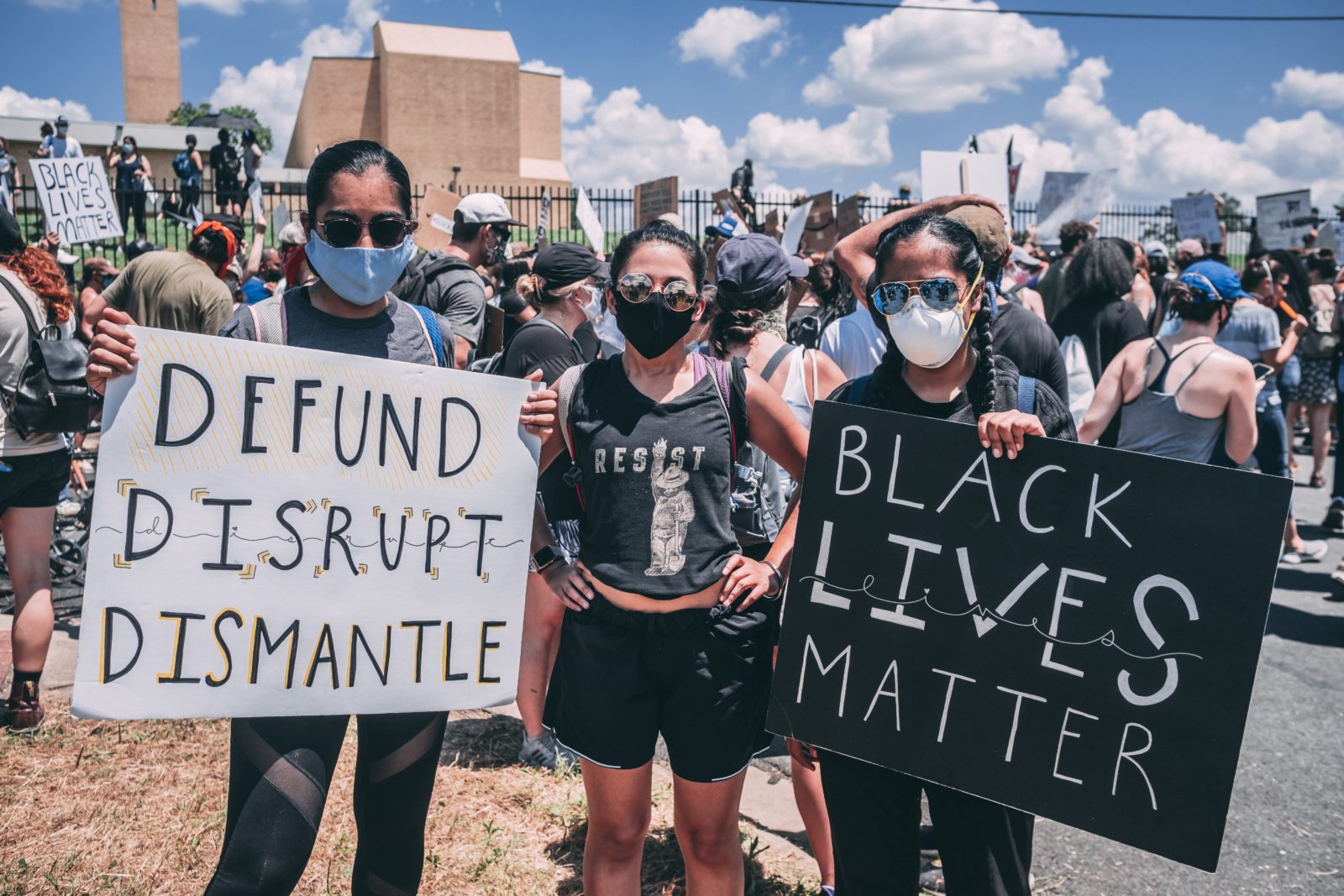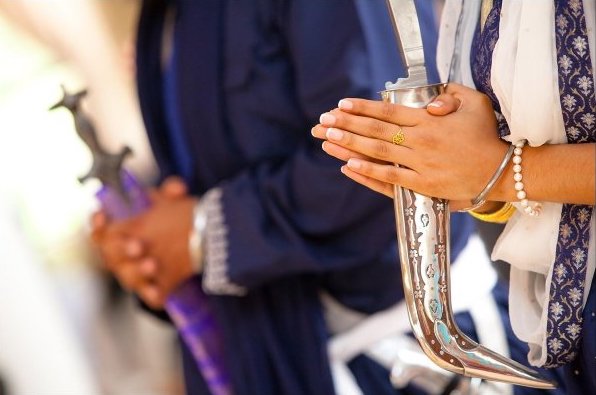This article is part of Kaur Life’s Black Lives Matter series created by Kaur Life board members and project advisors. Be sure to check out all of the articles.
Article 1: Should Sikhs Care About Black Lives Matter?
Article 2: Why Should Kaurs Support BLM?
Article 3: How Does anti-Blackness Show Up in the Sikh Community?
Article 4: How and Why do Sikhs Align with Whiteness?
Article 5: How Sikhs Can Become Anti-Racist and Support Black Lives Matter
Why should Sikh women care about Black Lives Matter (BLM)? Earlier, we made the case that Sikhs, in general, should care. Here, we will connect it specifically to Sikh women.
Our Liberation is Co-bound
As Sikh women, it is important to stand up for marginalized peoples. “I see our liberation as Sikh women deeply connected to the liberation of other People of Color,” says Lakhpreet Kaur, Editor in Chief of Kaur Life. “The same systems that oppress… Black People are the systems that oppress women, Sikh women, and Sikhs. These systems are built for and by cis-gender, heterosexual, wealthy, white men. By challenging anti-Blackness and power structures that benefit from marginalizing and ‘othering’ people, like Sikh women, we are also chipping away at sexist systems.”
“Oppressive systems like white supremacy*, colorism, racism, and xenophobia work together to harm people of color. So if one community is oppressed, it is as if we all are,” write South Asians for Black Lives. “Dismantling anti-Blackness and building racial solidarity is a matter of urgency, our racial solidarity is a matter of urgency, our survival depends on it because our liberation is bound together.”
We Must be Intersectional
We can’t fight for Sikh women’s rights and ignore how different forms of discrimination combine, overlap, and intersect. “Different kinds of prejudice can be amplified in different ways when put together,” writes the International Women’s Development Agency.
According to bell hooks (author, professor, feminist, and social activist), feminists are those working to end sexism, sexist exploitation, and oppression. And, if we are striving to be Sikh feminists (like some view Guru Nanak Sahib to be) we must be intersectional Sikh feminists.
Intersectionality is acknowledging that humans experience all of their identities all the time, at once. It means realizing that an individual’s identities impact each other. It means recognizing the ways that systems of oppression interact and impact individuals.
Thus, we must recognize the interplay between any and all kinds of discrimination, whether it’s based on caste, religion, gender, race, age, class, socioeconomic status, physical or mental ability, sexual identity, or ethnicity. So, issues that affect Sikh women are also influenced by all the other identities that impact Sikh women. And when those individual identities are being attacked by external forces, our Sikh life is being attacked too.
“Intersectionality draws attention to the different invisibilities that exist in feminism, in anti-racism, anti-caste, class politics, etc,” writes Nupur Preeti Alok. “Basically, it compels us to attend to many different aspects of power that not everyone experiences. This is one way we can draw our attention to what has been erased from our histories, what we need to unlearn, what we need to challenge, and who needs to be given space to share power and have a voice of their own. More importantly, it helps us draw attention to the various ways in which power is sustained and limited to only a certain caste/class/race/gender in society and how oppression thus operates and works.”
At Kaur Life, we have seen how women’s experiences of Sikhi are based on the intermingling of multiple identities. For instance, if a Sikh woman is Black, then she may feel marginalized on several fronts – by misogyny and sexism because she is a woman, by racism because she is Black, and by intolerance because she is Sikh. At a larger level, when Black people are being oppressed, it means white supremacy systems are at play, and those systems are steeped in bigotry and misogyny, which in turn subjugate Sikh women. We cannot just fight for one identity because that single identity is influenced by other traits, forces, and systems…and these systems work together to uphold each other.
Going beyond Sikhs, if we are going to clamor for women’s rights, we cannot run the risk of adopting White Feminism. “True feminism has the power to transform society,” writes Dr. Monnica T. Williams. “But too often what is advanced as feminism is actually White supremacy in disguise – a counterfeit we sometimes call White Feminism.” Dr. Williams describes White Femimism as a racist ideology that claims to speak for all women while ignoring the needs of women of color and suppressing those voices.
As Sikhs, we must include the voices, experience, and issues of cis and trans Black women and of other women of color. Supporting and advocating for those whose identities cross intersections that are foreign to ours is imperative; it is a Sikh value to be empathetic and stand up for other people’s rights. Being too Sikh-centered is simply an indulgence of ahankaar (ego/pride) and haumai (ego). The value of compassion and empathy was revealed to Guru Arjan Sahib, Ang 136.
ਅਠਸਠਿ ਤੀਰਥ ਸਗਲ ਪੁੰਨ ਜੀਅ ਦਇਆ ਪਰਵਾਨੁ ॥
aThasaTh teerath sagal pu(n)n jeea dhiaa paravaan ||
Being kind to all beings is more meritorious than bathing at the sixty-eight sacred shrines of pilgrimage and the giving of charity.
In Sikh History
The Gurus were not one-issue revolutionaries. They adopted intersectionality when addressing the oppression of people and provided alternatives for those seeking community and liberation. For instance, some women in South Asia at the time had limited economic rights because of their sex, were denied personal liberty because of their age, were barred from sacred spaces because of their caste/race, and were denied safety because of their religion. The Gurus addressed all of these issues holding women back by creating spaces that honored them as full, complex, multidimensional humans.
Reflecting on the Guru’s work reminded us of “radical love” that bell hooks writes about and defines in her work: love as a practice of freedom, love being based in intention and action, and love being fighting against systems of oppression. “Love in Sikhi renders similar for me as the practice of seva and justice work is a result of radical love that is core to Sikh principles,” says project advisor, Jaipreet Kaur.
Conclusion
To start or continue your journey on becoming an anti-Racist, check out our list of resources, actions, advocacy, and self education you can engage in. We’ve also included a section on how you can challenge racism in your families, amongst friends, in sangat, and at Gurdwara.
We also recommend these resources to brush up on intersectional feminism:
Why I’m Giving up on Intersectional Feminism
The Revolutionary Practice of Black Feminism
The Best Books for Budding Black Feminists
Black Feminist Thought in the Matrix of Domination
*A note on white supremacy
From Harleen Kaur, Kaur Life Board member, PhD candidate in Sociology, studying white supremacy & institutional racism:
While our modern understanding of white supremacy is very much rooted in neo-nazi groups, like the KKK, white supremacy is as simple as the idea (explicit or unacknowledged belief) that white people are innately superior/deserving of better treatment/livelihood/etc.
White supremacy is “a political, economic, and cultural system in which whites overwhelmingly control power and material resources, conscious and unconscious ideas of white superiority and entitlement are widespread, and relations of white dominance and non-white subordination are daily reenacted across a broad array of institutions and social settings,” Ansley, Frances L. 1989. “Stirring the Ashes: Race, Class and the Future of Civil Rights Scholarship.” Cornell Law Review 74(6):993–1077.
Within that, we also have the counter force of anti-Blackness, or the idea that Black people (and other racialized people who are not white) do not deserve the same treatment, and in fact much worse.
This article is part of Kaur Life’s Black Lives Matter series created by Kaur Life board members (Lakhpreet Kaur, Isha Kaur, Harleen Kaur, Dr. Mohan Singh, & Sukhjinder Kaur) and project advisors (Jaipreet Kaur & Darsh Singh). Be sure to check out all of the articles.
Article 1: Should Sikhs Care About Black Lives Matter?
Article 2: Why Should Kaurs Care About BLM?
Article 3: How Does anti-Blackness Show Up in the Sikh Community?
Article 4: How and Why do Sikhs Align with Whiteness?
Article 5: How Sikhs Can Become Anti-Racist and Support Black Lives Matter
Feature photo by Princepal Singh. All rights reserved. Photo cannot be used, replicated, modified, or distributed without the express consent of the photographer. Special thanks to Princepal Singh for sharing this photo he took at the Austin Justice Coalition’s Black Lives Rally and March which took place in Austin, TX on June 7, 2020. Pictured (L to R) is Isha Kaur, Harjot Kaur, and Sehaj Kaur.





No Comments